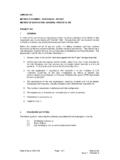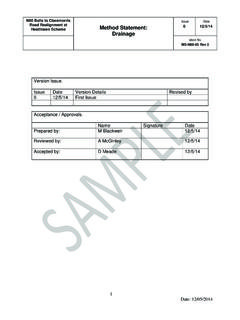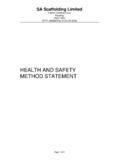Transcription of METHOD STATEMENT FOR DRILLING - Archway Engineering
1 Sample OnlyMETHOD STATEMENT FOR DRILLING & SAMPLING WITH ARCHWAYCOMPETITOR RIGG eneralThe Competitor is designed to sink boreholes up to 130 mm diameter through soils and weakrock, including clays, silts, sands, gravels and chalk. The rig is primarily used for shallow siteinvestigations to a maximum depth of 10 metres, and for carrying out in-situ tests (SPT andDP) to a maximum depth of 15 metres. In practice, the actual depth achieved is dependent onlocal ground rig consists essentially of a mechanized drop-weight that repeatedly falls onto an anvil,driving attached sample tubes or probe rods into the ground. The METHOD can therefore beclassified as a form of drive sampling in which a tube or split tube sampler having a sharpcutting edge at its lower end is forced into the ground by dynamic impact (BS 5930: 1981).After driving samplers to the required depth, they can be simply extracted using an integralhydraulic ram on the rig. No separate jacking system is samples obtained by this METHOD can be classified as either disturbed, or undisturbed,depending on the type of sampling apparatus used in conjunction with the rig (see below forcharacteristics of compatible sampling apparatus).
2 Although the rig operates primarily as a soil sampling tool, the Competitor is also capable ofconducting Standard Penetration Tests (SPT and SPT(C)) and Dynamic Probing (DP), to BS1377: Part 9: 1990. The drop weight and drop height can be adjusted on the Competitor tosuit either rig has the facility to drive casing into the ground, simultaneously with a soil sampletube. Using this system means that any overburden/loose ground can be sampled without holecollapse, ensuring that successive samples are accurate from the depth taken. This systemalso allows for the easy installation of standpipes, gas monitoring tubes or otherinstrumentation, within the restrictions of the borehole Competitor can be used in conjunction with a concrete core drill fastened to the anvil atthe base of the rig. This enables hard surfaces to be cored prior to sampling or testing theground underneath. There is however no facility for rotary coring of the sub-surface at depthsgreater than 1 metre Competitor METHOD has been found to be significantly more efficient than CablePercussion Boring in situations where several shallow boreholes (<10 m.)
3 Depth) are rig can be mobilized rapidly between different borehole locations and there is virtuallyno set up time. Under favourable conditions 30 metres of borehole sampling can be achievedduring one 8-hour METHOD is ideally suited for restricted access and limited-headroom work. The rig canpass through a domestic doorway and work inside a building with a minimum headroom of2750 mm. The rig is adept at sampling on slopes and embankments up to 20 , the METHOD is limited in the depth and diameter of sampling that is possible. Themaximum borehole diameter produced by the Competitor is 130 mm, and the maximumsample diameter is 100 mm, reducing as the borehole becomes OnlySampling ProcedureA) The Operator when working as a sub-contractor shall communicate with theEngineer/Client prior to visiting the site to determine the nature and scope of the workrequired. The Operator shall ascertain the nature and location of any risk and the level ofprecautions recommended for safe site work.
4 The Operator shall also ascertain whether theEngineer/Client is providing any special measures to prevent or adequately control exposureto contamination, portable hygiene facility, disposable clothing etc. Communicationsshould be in writing, and shall be incorporated into the contract documentation at thespecification and procurement stage of the ) The locations to be drilled are to be shown on a site plan or as indicated by theEngineer/Client. Such locations are to be clearly agreed and marked out on site ) At each borehole position the Operator shall test the ground for buried cables using a CATor similar device prior to DRILLING . If any doubt exists concerning the safety of DRILLING at aparticular location, a trial pit shall be dug by hand or an alternative borehole position shall beagreed in consultation with the ) The sampling rig is moved into position over the prospective borehole. Stabilizing legs arefitted to the base of the rig and secured by locking pins.
5 The rig is then jacked level to ensuremaximum stability during the sampling procedure. Using the rig hydraulics, the slidingcarriage is raised and the sample tube is screwed onto the anvil adaptor. The carriage is thenlowered until the cutting edge of the sampling tube rests on the ground surface. The hydrauliccylinder is lowered and the drop-weight is activated, driving the sampler into the the sampling tube has been driven to its full length, the hydraulic cylinder is activatedpulling the sample tube from the ) Sampling proceeds to greater depths by successively adding drill rods between the sampletube and the anvil adaptor, repeating the procedure described in (D) above. In order to reduceany tendency of the sampler tubes to stick within the borehole, the diameter of the sampletube used may be decreased as the borehole becomes deeper. A succession of sample tubes inreducing diameters may be used to obtain the full depth of the ) Sampling shall continue until the depth required by the Engineer/Client is reached, or untila "refusal" occurs, whichever occurs first.
6 A refusal is defined as occurring when penetrationof the sample tube ceases, or is barely perceptible. When penetration stops, the drop weightmay be observed to "bounce" on the anvil and at this point DRILLING must cease immediately inorder to prevent mechanical damage to the rig. If requested by the Engineer/Client the depthat which a refusal occurs may be confirmed by carrying out a Standard Penetration Test (seebelow)G) Care must be taken when withdrawing sample tubes from the ground as the mast of the rigis not designed to withstand full cylinder force at the travel extremes of the carriage. Once thesample tube is clear of the ground, the hydraulics must be made safe before the sample tube isunscrewed and the sample ) The preparation for and methods of taking samples, together with their size, preservationand handling will be in accordance with British Standard BS 5930: 1981 - Code of Practicefor Site Investigation, and the Contract OnlyI) Samples will be labelled both inside and out with the project name, project number, holenumber and depth of top of the sample.
7 All samples will be protected from temperaturesbelow 5 and above 25 degrees Celsius, and from wetting or drying out due to ApparatusA) The sampling apparatus shall be selected on the basis of the quality of the sample that isrequired, and should be assessed largely by the suitability of the sample for appropriatelaboratory tests, in accordance with BS 5930: 1981. The appropriate apparatus should beselected in close consultation with the ) A Window Sampler consists of a steel tube incorporating a longitudinal slot or window along one side, through which a soil sample can be removed. Typically, such tubes range indiameter from nominal 90 mm to the smallest diameter nominal 40 mm. The tube may bechamfered at its lower end to form a cutting edge, or provided with a heavy-duty cuttingshoe. The sample tubes have an area ratio ranging from 24% for the largest diameter tubes to64% for the smallest diameter tubes. The soil profile obtained by this METHOD can be visuallyexamined and photographed if necessary.
8 Pocket penetrometer tests can be carried out on thesample through the open window of the tube. In the process of removing a sample from thetube, the soil becomes highly disturbed and can only be regarded as a Class 3 sample asdefined by BS 5930: 1981. Therefore the samples obtained are only suitable forclassification, determination of moisture content or for contaminant analysis. In geo-environmental investigations care must be taken to thoroughly clean out the tubes betweensuccessive uses, to prevent cross-contamination of samples. This can be problematic onsensitive sites where use of a jet wash or steam cleaner may cause unacceptable ) A Windowless Sampler is very similar in principle to a Window Sampler (see B, above)but in this case the sample tube lacks a window, and incorporates a plastic liner that retainsthe sample. The plastic liner greatly facilitates handling, presentation and preservation of thesoil sample and enables a complete ground profile to be presented to the Engineer/Client forsubsequent analysis.
9 Windowless Samplers range in diameter from nominal 100 mm down tonominal 50 mm. The area ratio of a Windowless Sampler is somewhat greater than a WindowSampler of the same diameter, due to the presence of the plastic liner and the thicker cuttingshoe required to retain it. Soil samples are disturbed by driving process and can be regardedas Class 3 samples. The major advantage of using Windowless Samplers is that the plasticliner greatly reduces the possibility of cross-contamination between successive samples. Thisis the preferred METHOD of sampling in geo-environmental ) A Shelby Tube Sampler (or Thin-walled Sampler) is used for soils that are particularlysensitive to sampling disturbance, and consists of a thin-walled steel tube with a chamferedcutting edge. Samples of nominal diameter 75 mm or 100 mm are generally obtained and thearea ratio is about 10%. These samplers are suitable only for fine soils up to a firmconsistency, and free from large particles.
10 They generally give Class 1 samples in all finecohesive soils, including sensitive clays. It is to be noted that disturbance at the base of theborehole will occur in weak soil below a certain depth due to stress relief. Shelby tubes thatpenetrate well below the base of the borehole are therefore preferable, but in practice tubelength is restricted by the weight of sample that can be retained successfully during extractionof the OnlyE) U100 Samplers can be used in all cohesive soils and in weak rock, such as chalk,producing a nominal 100 mm diameter sample. In non-sensitive, fine cohesive soils theequipment may give Class 1, or more likely Class 2 samples. In brittle or closely fissuredmaterials such as weak rock, hard clay and stoney materials the sampler gives Class 3samples. The design of the sampler to be used in conjunction with the Competitor rigconsists of a 115 mm OD sample barrel, enclosing a thin aluminium liner with an internaldiameter of mm.






